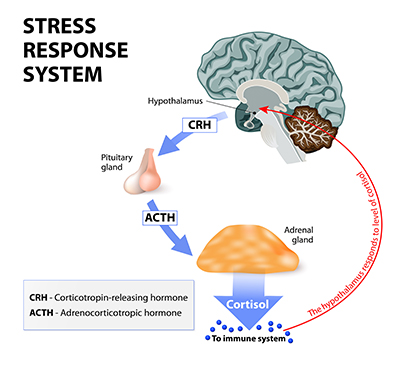Destressing with the Senses: Naturopathic Approaches
“Stress is a killer.” At some point, we have all heard this very common phrase. It is well-known that stressful things drain vitality from human beings. Financial issues, relationship issues, and workplace issues are enough to break anyone’s bubble. That’s not even touching the stresses and trauma we have been gathering and carrying since childhood. In order to truly reduce the physical/chemical/emotional stress in our lives, we must understand what stress does to our bodies and why.
While the stimuli that cause stress often come from the outside world, it is our organs and hormones which carry out their response. Our senses of sight, smell, taste, hearing, and touch pick up information every millisecond we are alive. This data enters our brain in different quantitative and qualitative forms. Quantitative data would qualify as anything that can be measured and recorded in terms of numbers. This type of information can be checked for accuracy and will never vary. Qualitative data tends to be the complete opposite. It cannot be purely logistically categorized, because we cannot measure it nor count it with numbers. It is not something that can be reproduced 100% the same by every person. This is the reason we say qualitative information cannot be accurate but is variable instead.
Millions of examples highlight sensory qualitative and quantitative experience. For the sake of simplicity, let’s imagine looking at a lake in front of us. We can measure that the lake has 47 willow trees at the edge. It is 1 km long, 0.5 km wide, with a water temperature of 27 °C. These are all quantitative descriptions we gaged with our senses. However, noticing that the emerald green reflection of the willow trees on the sapphire blue surface of the water brings joy to our soul or that the warm water melts our muscles like butter are qualitative sensory perceptions.[1] Both these observational types warn our body about the potential dangers/threats we perceive in this world. Our brains take this information, which then can cause the release of hormones and neurotransmitters in our body.
Learning about all these molecules can take years, so we will boil it down to the two you may have heard of, cortisol and adrenaline. Both these hormones are produced in a tiny pyramid-shaped structure, one sitting atop each of your kidneys, called adrenal glands. These glands are vital to our survival. They get their orders from the hypothalamus. The hypothalamus can be likened to the command centre of our brain, conducting the function of many other organs. So, the hypothalamus sends a biochemical warning to our adrenal glands every time something stressful occurs inside or outside of the body. The adrenal glands then release cortisol, known as “the primary stress hormone.”[2] Cortisol forces glucose (aka blood sugar) into our bloodstream. Glucose is the primary energy source the brain can use. It is needed to think on our feet and make snap decisions. Another fascinating action of cortisol is that it will suppress any body functions which are not necessary for immediate survival.
 Reproduction, digestion, and growth are all put on the backburner when cortisol floods our body. Our immune system is also changed by the release of cortisol; one of the main reasons stress truly can be a killer.[2] Adrenaline is another hormone released by the adrenal gland. This hormone will increase our blood pressure, raise our heart rate, and increase our energy supply to deal with the stressful threat.[2] We as humans perceive the resulting changes as being stressed out. As stated previously, there is much more to the body’s stress saga that has not been described here for the sake of time and space.
Reproduction, digestion, and growth are all put on the backburner when cortisol floods our body. Our immune system is also changed by the release of cortisol; one of the main reasons stress truly can be a killer.[2] Adrenaline is another hormone released by the adrenal gland. This hormone will increase our blood pressure, raise our heart rate, and increase our energy supply to deal with the stressful threat.[2] We as humans perceive the resulting changes as being stressed out. As stated previously, there is much more to the body’s stress saga that has not been described here for the sake of time and space.
Now that we have a better understanding of what stress means to the body, let’s examine ways to modulate that experience. There are hundreds of millions of different ways to be stressed. In fact, it can be a little stressful just thinking about all the types of stress we experience daily! Now, we know that our senses are the receptors for those perceptions. If we focus on each sense, we can find simple and easy ways to avoid triggering the feedback loop we mentioned above.
To begin, we can start with the sense of sight. Different wavelengths allow our brain to perceive different colours in the spectrum of visible light. Anyone who is not colour-blind has seen tones ranging from red, orange, and yellow to the opposite end of the spectrum including green, blues, indigo, and violet. Using these colours to heal our bodies, thereby reducing stress, is known as colour therapy. Different wavelengths, which are perceived by our brain as different colours, elicit different responses in the body.
- Red (with a wavelength of 700–635 nanometres [nm]) is very stimulating; this can help increase our energy by optimizing the function of our cardiovascular system, muscles, and blood. As prolonged exposure to red light may increase aggression, this is a case where more is not necessarily better. We should aim to only expose ourselves to a predominantly red light no more than five to ten minutes at a time.
- Orange (635–590 nm) is famous for increasing our sense of warmth and relaxation; it is often used to help move the lymph in our body.
- Yellow (590–560 nm) is known to improve the mood and digestion. However, people who suffer from paranoia need to exhibit great caution when using primarily yellow light. Like the red frequency, we should only expose ourselves to yellow light for a duration of five to ten minutes at a time.
- Green (560–520 nm) helps promote healing in all our body’s systems and is the least irritating. That is why it is often used for extended lengths of time and as part of hydrotherapy.
- Cyan (light blue) (520–490 nm) is most anti-inflammatory and soothing, which greatly lessens the stress response.
- Blue (including indigo/dark blue; 490–450 nm) helps us deal with matters of integrity, realization, and intuition.
- Violet (450–400 nm) assists us in times of evolution and with wisdom/inspiration.[3][4]
To embrace releasing stress on the quantitative visual spectrum, try to find love and beauty in everything. Make a list of what you love or find beautiful in physical/mental/emotional/spiritual reality—no holds barred, no judgement, no shame. Allow yourself to reject the notion of focusing only on what is going wrong. Celebrate what is going right! Literally open your eyes to the positive blessings you do have right in front of you.
Next, the sense of olfaction (the medical term for smell) is a powerful ally in relieving stress. Humans have an intimate relationship with smell. An odour binds receptors in our nostrils, which eventually touches our brain through the first cranial nerve. “In recent years, various studies have revealed that olfactory stimulation through fragrance inhalation exerts various psychophysiological effects on human beings.”[5] Especially tied to our memories, positive/comforting smells that are special to our story should be mindfully applied in our life. For example, my childhood home had a whole row of roses along the back wall, that my mother grew with love, loyalty, and strength. It’s no easy feat to raise thriving roses in the Arizona desert where I grew up… just like it was not easy to raise her first child ever born on American soil to become a naturopathic physician. So, while I have always adored a rose’s scent, it holds a deeper meaning for me now. When I use a rose-scented candle, lotion, perfume, massage oil, essential oil, or anything else, it steadies me. I almost immediately feel stronger, comforted, and loved. Think back through all your experiences and try to find scents that have meaning; then, begin incorporating them in your daily grind. If you are looking for new scents scientifically proven to combat stress, try rosemary, geranium, orange, cypress, bergamot, juniper, spearmint, rose, lavender, or jasmine.[5]
 In transition, we come to taste. Unfortunately, we have all had our tastes/appetites affected by stress. Whether we eat more or less as a result, emotional eating is something everyone has done at least once. In this spirit, we enact the 80/20 rule: It means that 80% of the time, we consume nutrition best for our bodies while still engaging fantastic flavour. The other 20% of the time, we plan our indulgence. Let me be clear: It is not cheating—we aren’t doing anything we are ashamed of; we have planned our indulgence to know our limits.
In transition, we come to taste. Unfortunately, we have all had our tastes/appetites affected by stress. Whether we eat more or less as a result, emotional eating is something everyone has done at least once. In this spirit, we enact the 80/20 rule: It means that 80% of the time, we consume nutrition best for our bodies while still engaging fantastic flavour. The other 20% of the time, we plan our indulgence. Let me be clear: It is not cheating—we aren’t doing anything we are ashamed of; we have planned our indulgence to know our limits.
Fourthly, we arrive at our auditory sense. Again, this form of quantitative sensory experience is a universal treatment for stress. Ironically, we get so busy/overwhelmed that we oftentimes subconsciously forget to bring that form of healing to our hearts and homes. I encourage all my patients to always expand on their “personal sound.” Expand how often they listen, why they listen, what, where, and how—because it usually teaches them about who they are in the process. Music is vibration and has been soothing humans since humans existed. In recent years, science has gathered more data on its quantitative stress-relieving properties. Known as solfeggio frequencies, these tones have been proven to help our mind-body spectrum overcome emotional and chemical stress. Scientists found 396 Hertz (Hz) liberates guilt/fear, 417 Hz unravels situations and facilitates change, 528 Hz is for transformation and DNA repair, 639 Hz for relationships and connecting, 741 Hz for solutions and expressions, and 852 Hz for returning spiritually to order.[6]
 Lastly, our sense of touch may be our most powerful tool to combat stress. Even if we ignore the centuries of research on how healing physical sensation is, we cannot ignore how much better we feel after an embrace from someone we love and trust. Almost everyone on this planet has at least once felt better from being given physical affection; not everyone has to be “touchy-feely” to benefit. We have evidence of massage as a healing art to banish stress as from 2700 BCE in China, 2500 BCE in Egypt, and 1500 BCE in India.[7] The world too often forgets that sports, games, hobbies, and the arts are all things that involve touch and imply motion. Relieving stress through your favourite forms of moving is the best thing you can do for your body, mind, and spirit. Dance, play with your kids, go fishing, play ball, hike, craft, create… do anything you desire mindfully to expel whatever negativity is bringing you down!
Lastly, our sense of touch may be our most powerful tool to combat stress. Even if we ignore the centuries of research on how healing physical sensation is, we cannot ignore how much better we feel after an embrace from someone we love and trust. Almost everyone on this planet has at least once felt better from being given physical affection; not everyone has to be “touchy-feely” to benefit. We have evidence of massage as a healing art to banish stress as from 2700 BCE in China, 2500 BCE in Egypt, and 1500 BCE in India.[7] The world too often forgets that sports, games, hobbies, and the arts are all things that involve touch and imply motion. Relieving stress through your favourite forms of moving is the best thing you can do for your body, mind, and spirit. Dance, play with your kids, go fishing, play ball, hike, craft, create… do anything you desire mindfully to expel whatever negativity is bringing you down!
Bianca Despotides, ND
It is Dr. Bianca’s mission to help her patients attain physical, mental, and spiritual health using natural methods. She is passionate about educating her community about the benefits of naturopathic medicine.
desertclinics.com/profiles/bianca-despotides
References
- Areej, J., and V. Stefan. “How are quantitative and qualitative observations different?” Socratic: Chemistry. · https://socratic.org/questions/how-are-quantitative-and-qualitative-observations-different · Posted 2018-03-25 · Accessed 2019-02-03.
- Mayo Clinic Staff. Healthy Lifestyle: Stress Management. · https://www.mayoclinic.org/healthy-lifestyle/stress-management/in-depth/stress/art-20046037 · Updated 2016-04-21. · Accessed 2019-02-03.
- Brook, D. “How light therapy can help your mood.” mbg health. · https://www.mindbodygreen.com/0-6603/How-Light-Therapy-Can-Help-Your-Mood.html · Posted 2012-10-29. · Accessed 2019-02-03.
- Hull, Dr. G. Handout on color therapy. · 2015
- Sowndhararajan, K., and S. Kim. “Influence of fragrances on human psychophysiological activity: With special reference to human electroencephalographic response.” Scientia Pharmaceutica, Vol. 84, No. 4 (2016): 724–751.
- Attuned Vibrations. What are the Solfeggio frequencies? · https://attunedvibrations.com/solfeggio/ · Accessed 2019-02-03.
- All Allied Health Schools. History of Massage Therapy and How it Evolved. · https://www.allalliedhealthschools.com/massage-therapist/massage-therapy-history/ · Accessed 2019-02-03.

 Stores
Stores